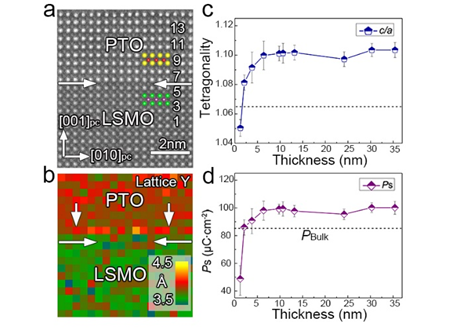A research team led by Prof. MA Xiuliang and Prof. ZHU Yinlian from Institute of Metal Research, Chinese Academy of Sciences (IMR, CAS) recently found giant polarization sustainability in a series of ultrathin PbTiO3 films scaled down to three unit-cells. This study was recently published in Advanced Materials.
Ferroelectric oxides, featuring asymmetric or polar structures that are switchable under an external field, are required to take the form of nanoscale films in future electronic devices. However, the ferroelectricity is generally deteriorated or even vanishes when the ferroelectric films are downsized to unit cell scale. It is known rather difficult to maintain and enhance the polarization in nanoscale ferroelectrics.
Thanks to a long-standing tradition with several decades of applying transmission electron microscopy to materials science, this team has artificially produced a series of ultrathin PbTiO3 films scaled down to three unit-cells grown on NdGaO3(110) substrates with La0.7Sr0.3MnO3 as bottom electrodes and found the novel phenomenon of giant polarization sustainability.
The giant enhancement of polarization in the present films is proposed to result from the charge transfer at the La0.7Sr0.3MnO3/PbTiO3 interface, as supported by the atomic mapping via aberration-corrected scanning transmission electron microscopy and by the anomalous decrease of Mn valence measured from X-ray photoelectron spectroscopy.
This study reveals the significant role of charge transfer at interfaces in improving large polarizations in ultrathin ferroelectrics and is of scientific and technological importance for the development of future electronic devices.

Figure: Identification of giant polarization sustainability in ultrathin ferroelectric films. (a) An atomic resolved HAADF-STEM image showing the PTO/LSMO interface; (b) Out-of-plane lattice spacing map for (a). (c) Evolution of c/a ratio with film thickness; (d) Evolution of the spontaneous polarization with film thickness. The spontaneous polarizations are derived from c-lattice parameters based on Landau-Ginzburg-Devonshire theory. (Image by IMR)